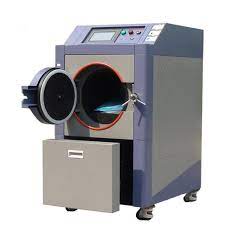The world we are living in is shaped by the emergence of new and modern technology and advancements. From the mobile we use to the car we drive, everything has become more advanced and precise. This is due to many industries but the thriving force behind it is the electronics industry. It is, therefore, vital to conduct proper testing mechanisms for electronic components by saturated or un-saturated HAST Chambers before they get exposed to the atmosphere of the consumer market.
There are already established mechanisms to test the performance and durability of electronic components. Some are fast and some are slow. The most efficient and highly considered mechanism nowadays is HAST testing. Highly Accelerated Stress Testing (HAST) is used to test the performance and durability of electronic components under high-stress conditions. These conditions are usually high-stress temperature and humidity levels. These tests are conducted in HAST chambers.
HAST is famous for its quick testing methods. It is used to test various electronic components like semiconductors, integrated circuits, and many more. It tests electronic components and identifies any design flaws, shortcomings, or failures. This helps in keeping the product quality high and meeting the user expectations. HAST has two types: saturated HAST chamber and unsaturated HAST chamber. This article delves into the differences between the two types in detail.
Types of HAST Chambers
As already mentioned, there are two types of HAST chambers. One is saturated and the other is unsaturated. Read on to understand the difference between the two.
1. Saturated HAST Chambers
The operating and testing conditions of saturated HAST chambers are as follows:
Pressure
Saturated chambers operate at 2 atmospheric pressure. This is generally greater than the operating conditions of unsaturated chambers.
Temperature
Saturated chambers can maintain a temperature range from 85 degrees to 130 degrees Celsius. This is generally considered good for the testing of electronic components. It makes sure that all the electronic material works perfectly fine at high-temperature ranges.
Humidity
A humidity level of 100 percent is maintained at saturated HAST chambers. This phenomenon is done by creating an environment where air is saturated with steam. This is done to test the electronic components which might have applications in humid environments.
Testing Duration
The test duration of saturated HAST chambers is shorter than that of unsaturated HAST chambers. This high accelerating factor is due to the high levels of humidity, pressure, and temperature. This results in quick identification of potential flaws in electronic components.
Objective
Due to the quick testing duration of saturated HAST chambers, it is only able to highlight short-term flaws and ambiguities in the electronic components. It provides a more aggressive environment than unsaturated chambers for this purpose.
Pros & Cons
Saturated chambers have the advantage of being more realistic in terms of simulating the humid conditions that the electronic components may face. However, they have the disadvantage of being too expensive and complex to conduct operations.

2. Unsaturated HAST Chambers
The operating and testing conditions of unsaturated HAST chambers are as follows:
Pressure
The pressure in unsaturated HAST chambers is lower than the saturated HAST chambers. They have an atmospheric pressure of one or slightly more than this.
Temperature
Additionally, unsaturated chambers are capable of maintaining temperatures between 85 and 130 degrees Celsius. This is typically regarded as beneficial for testing electronic components. It ensures that all electronic components function flawlessly at extreme temperature ranges.
Humidity
The humidity level of unsaturated chambers is not 100 percent as in the case of saturated chambers. They usually maintain this humidity level by injecting water vapors into the chamber’s atmosphere. These chambers are used to test electronic components that are exposed to less humid conditions.
Testing Duration
Unsaturated chambers generally take a longer time for testing as compared to saturated chambers. This is because their humidity levels are not kept at maximum saturation.
Objective
The main goal of unsaturated HAST chambers is to detect flaws and shortcomings in electronic components for long-term sake. They test the long-term performance and reliability of the electronic components. This gives them a slight edge over saturated HAST chambers.
Pros & Cons
The main benefit of unsaturated HAST chambers is their low cost, but one drawback is that they can’t accurately simulate the possible humidity levels that electronic components can experience.
Conclusion
Saturated and unsaturated HAST chambers each provide a unique purpose, to sum up. Depending on our goals and needs, either one can be used. Unsaturated HAST chambers are better for determining the long-term dependability of the electronic components, while saturated HAST chambers are more appropriate for the early detection of defects.
